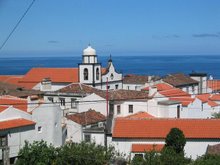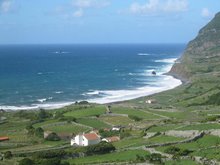Having been a minor league yottie on the west coast of Scotland in a previous life (though only a coastal day sailor which is a totally different kettle of rabbits from cruising the oceans), I immediately reached for the binoculars and followed its progress, smashing through the heavy seas, beating to windward close hauled (that's yot-speak for something it would be too tedious to explain to non-yotties) southwards (right to left) until it disappeared from view.
About an hour later, however, the yacht re-appeared much closer inshore, coming from left to right now ...
Makes sense, I thought: harbour at Lajes totally untenable in easterly, probably better off in comparative shelter of west coast at Faja Grande even with these gusts off the cliffs (although by now, the wind had moderated somewhat). The fact the yacht had approached FG by first disappearing out of sight to the left (south) and then reappearing inshore going in the opposite direction (instead of heading straight in from the position in the first photo) also made perfect sense to me as a nautical cove for reasons which, once again, I'll spare you. What did appear odd, however, was that the yacht was now closing the coast with only its foresails (the ones in front of the mast) set. To my coastal sailor's mind that breaks every rule in the book and I ascribed it to some mystery of oceanic sailing I was uninitiated in. Curious, however, I went down to the seafront for a closer look.
If there is one rule in the yottie's book (be he coastal or offshore), it's that, whenever you attempt an unorthodox manoeuvre within sight of land, there will be someone on shore peering through binoculars making adverse comments ("What the hell's he doing that for?") Subsection (1) of that rule is that, once close enough in, the same person will drop the binoculars and begin to communicate with you by ambiguous hand gestures. One of these involves cupping his hands round his mouth with no apparent result. Subsection (2) involves a second person joining the first and making gestures which appear to contradict the first person's.
Having proverbially "been there, done that", I forebore from any attempt at communication with the yacht ("I say! Once you've dropped the hook - over THERE would be better! - do row ashore and pop up for pre-prandials!") Anyway, it was one of these days, weatherwise, getting dark soon as well, when I was pretty glad to be able to step back into a car and drive home rather than being on a yacht, keeping watch in the rain taking transits fretting about whether the anchor was going to hold.
The following morning (Monday, 29 April), I happened to glance out the window and see the Lajes pilot cutter apparently attempting to rendezvous with the yacht and take it under tow. Very difficult in a big sea but after much to-ing and fro-ing a line was secured and off they went.
I asked José António at the shop if he'd heard what the story was but he hadn't and, beyond looking at the Lajes webcam to checking that the yacht had duly arrived there (it had) ...
... I didn't think about it again until Friday (3 May) when I got a tip that there was a blog by a solo yachtsman who'd fetched up in Flores in slightly fraught circumstances and did I know anything about this?
Turns out the yacht is called Wild Song and belongs to one Paul Heiney (British readers may recognise the name of the BBC radio presenter.) You can read the blog here - for the approach to Flores, scroll down to the entry titled "Low in every sense" on 24 April and read up.
The long and short is, after cruising in Patagonia for the winter (our winter - summer in the Southern Hemisphere of course), Wild Song left Uruguay on 25 February bound for her home port of Falmouth, UK via a planned stop at Horta on Faial in the Azores (a popular yachtsman's harbour). After nearly two months at sea, Wild Song was within 140 mile of Horta when contrary winds drove her west. Moreover, the yacht's engine wouldn't start due to dirt in the dregs of the fuel tank. The main problem that caused was no power for the water maker. Hence Paul decided to make for Flores instead.
In the unseasonably awful weather we've been having this spring, he described the 48 hours around his arrival at this island as the worst in his yachting experience.
To add to the lack of an engine, Wild Song's mainsail tore catastrophically during the approach to the dubious shelter of Fajã Grande. That explains the unusual set of sails I observed. In anything but the most benign of conditions, a yacht is very difficult to manouevre without a mainsail. And having lobbed out 60 metres of chain to anchor at FG, which would be almost impossible to get back up by hand without the engine to power an electric windlass (machine to pull chain up), all these factors combined to make Paul (reluctantly as a very last resort, I should imagine from my own experience) call for help. This was achieved by phoning the UK coastguard on his mobile who contacted their opposite numbers in Portugal and the net upshot was the pilot cutter (boat) came round the next morning to tow Wild Song to Lajes - a distance of about 12 miles (19km). Note also that the pilot cutter is kept out of the water and have had to be launched by crane to meet this exigency.
 |
| 12 miles (19km) from FG to Lajes |
But the troubles were only just beginning. With the yacht now free of her anchor, the tow rope to the pilot cutter broke five times before they got under way. On one occasion, Paul describes this as happening so close to the rocks of the shore, he could barely look. That must have been the lowest point of the worst 48 hours.
I watched this entire performance through the binoculars from my kitchen window and feel rather guilty now I was rubber-necking an event which must have been traumatic in the extreme for the participants.
 |
| Library picture of Lajes das Flores marina earlier this year |
As I type this, Wild Song is en route to Horta on Faial, 120 miles east, powered by a combination of light following winds and her engine as necessary. At Horta, she can get her main sail repaired (essential to face the long haul back to Britain).
I shall be following the blog with interest from hereon in. I was amused by the fact that, despite the trauma of his arrival in the Azores, Paul managed to pen the very shrewd observation that, in centuries gone by, sailors judged their proximity to land by smell, colour of the sea, seabirds, stuff floating in the water etc. etc. Nowadays, it's by a text message from Vodafone as your mobile phone acquires a signal saying "Welcome to Portugal! Calls to the UK cost ..."
How true!
.jpg)
.jpg)
.jpg)
.jpg)








8 comments:
The account that Paul Henley posted about his arrival on Flores seems to confirm stories my parents and their siblings told me about how it was like living on Flores in the early 20th century. They said that often during the height of the winter storm season, ships wouldn't be able to bring needed supplies for as long as a month.
About 10 or 11 years ago while visiting cousins on Flores, I got a taste of how volatile the weather can be on Flores, even in the summer. I decided to take a day trip over to Corvo with Mestre Jose Augusto. This was in late June or early July. I asked the cousins how I would do this and they made the arrangements. On the appointed morning, I presented myself at the port in Santa Cruz, got on the boat and off we went. After about 15 minutes, a tremendous squall came up. It started pouring rain and gusty winds came up so much so that we were forced to turn back. It can't be more than 4 or 5 miles between the two islands!! I didn't get to Corvo until a later trip to Flores.
John J. Vasconcelos aka Joao Jaime to my Flores cousins.
Son of Joao Vitorino Vasconcelos from Lomba and Ana Freitas de Corvelo from Fajazinha. (She was a second cousin of Captain Antonio Caetano Corvello, New Bedford whaling Captain).
Good story. And not the first time that Paul Heiney has been in great danger at the Deep End. try this http://www.youtube.com/watch?v=OmnK0ty0RBE
David
Thanks for your well-reported account, including pictures (I bet Cap'n. Paul would love to see them)! Like my cousin João Jaime above, I too wonder what the seas must've really been like in Fajã Grande/Fajãzinha back when my ancestors lived there, since the youngest ones who were old enough to recall (my great-grandparents) died before I was born, and of course my family kept its Portugueseness secret from me. You can only imagine what a thrill it was to visit the west coast of Flores in mid-June 2002 and take pictures at the Fajã Grande port, wondering whether that's where my family emigrated from. The closest I'd come previously was to read Alfred Lewis' semi-autobiographical novel "Home is an Island," which describes growing up in the early 1900s in Fajãzinha (as Lewis did before emigrating).
Thanks for the link to Paul's blog, as I'm enjoying his blogging his stay in Horta, too.
Re tomatoes: I suspect they're imported to the Azores off-season from Spain or Morocco, if only for tourists. But generally I regard an out-of-season tomato as scarcely worth eating. I recall in mid-June 2002 -- coincidentally, I was there just a couple of weeks before cousin JJ, although neither of us yet knew of one another's existence -- and already seeing luscious near-ripe tomatoes (as well as plump Bell peppers) in a home vegetable garden in Santa Cruz. I managed to scale the side wall of the garden, then dropped down into the garden in order to snap some photos of it, hoping all the while I wouldn't get caught; I'd never have tried this stunt in the US lest, under the Castle Doctrine -- named after the dictum "a man's home is his castle" -- a homeowner shoot first and ask questions later. But fortunately Azoreans don't seem to be so trigger-happy, and as I said, I didn't get caught anyhow.
Cap'n. Paul made it back to the UK last night, where presumably he'll be able to enjoy the comforts of home for a while (at least until the boat's repaired and he suffers his next attack of wanderlust):
http://www.sailblogs.com/member/wildsong
Have you attempted to contact Paul Heiney to alert him to your post re his suffering off the west coast of Flores? I'd think anyone in his situation would be delighted to see your photos and read your account -- IMHO it was among your Best. Blog. Posts. Ever!
Here's the link to Paul's "Final Reckoning" of his voyage, postead 1 Aug 2013:
http://www.sailblogs.com/member/wildsong
Did you ever hear from Paul?
Paul has just published an article that near the end mentions the kindness he encountered on Flores. I was unaware of the background story of his voyage until now.
"Paul Heiney: my journey to Cape Horn for the sailor son I loved and lost / Family tragedy inspired an adventure to face one of the world’s most perilous nautical challenges":
http://www.telegraph.co.uk/men/10746404/Paul-Heiney-my-journey-to-Cape-Horn-for-the-sailor-son-I-loved-and-lost.html
Neil – we're publishing Paul Heiney's account of his 48 hours off Lajes in Yachting World magazine. Can you contact us with a view to using a few of your photos? robert.melotti@timeinc.com tel: 01252 555176
Post a Comment